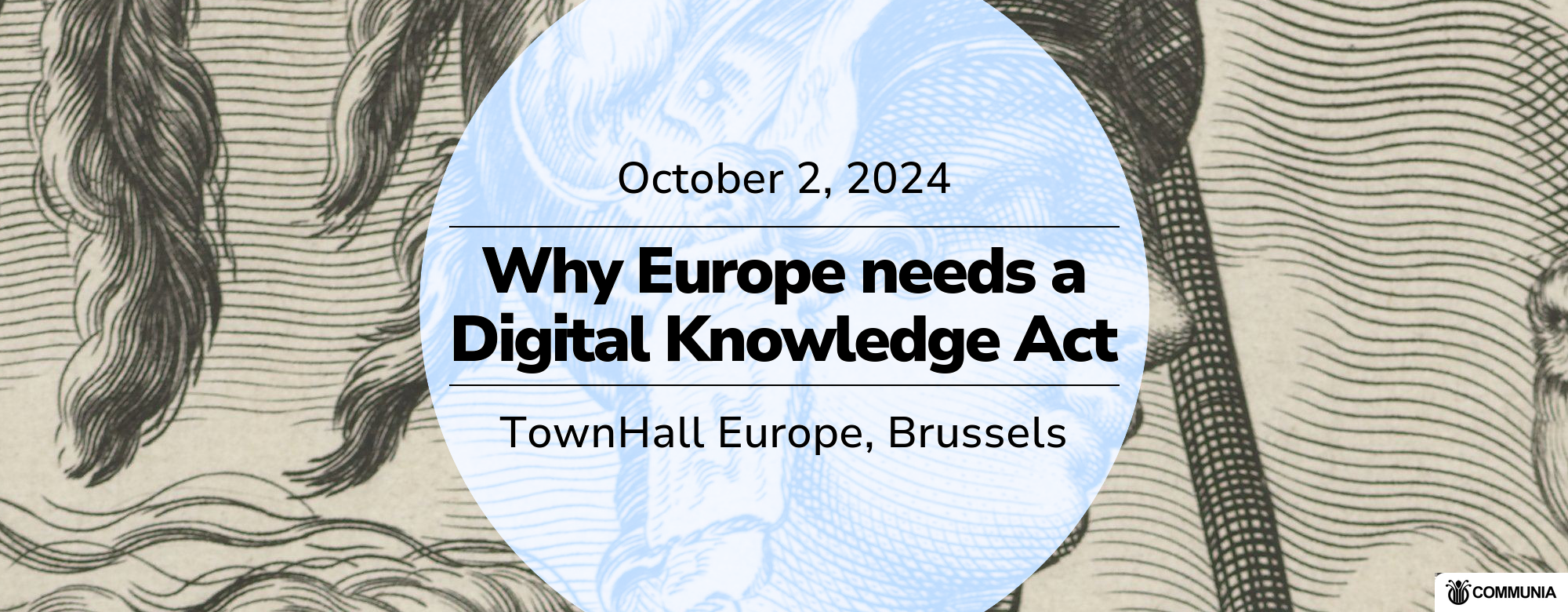COMMUNIA and Gesellschaft für Freiheitsrechte co-hosted the Filtered Futures conference on 19 September 2022 to discuss fundamental rights constraints of upload filters after the CJEU ruling on Article 17 of the Directive on Copyright in the Digital Single Market (CDSMD). This blog post is based on the author’s contribution to the conference’s third session “Beyond the Judgement: The Future of Freedom of Expression.” It is published under a Creative Commons Attribution 4.0 International licence (CC BY 4.0).
The changes brought by the CDSMD to the copyright paradigm cannot be underestimated. In addition to changing the liability regime for online content-sharing service providers (see Jütte), the obligation to introduce ex ante and ex post content moderation has the potential to turn copyright into a censorship tool if not adequately balanced against the right to freedom of expression. In the long run, the implementation of article 17 CDSMD bears crucial consequences for cultural diversity, creativity and the ability to participate in political and societal discourse online.
A strong commitment to respecting the right to freedom of expression
Whilst a strong commitment to freedom of expression is commended, the balance to be struck between the right to property of copyright holders and the right to freedom of expression remains uncertain, as the EU legislator and the CJEU in C-401/19 leave this matter for EU member states to resolve. The potential serious interference with the right to freedom of expression and freedom of the arts (guaranteed by articles 11 and 13 of the EU Charter of Fundamental Rights respectively) created by inadequate controls on content moderation is undeniable, as acknowledged by the AG (at 77 and 151). The AG also confirmed that this interference is ‘attributable’ to the EU legislature and should not be left in the hands of service providers (AGO, at 83-84). On the compatibility of this limitation with the right of freedom of expression, the AG went back to the basics by first reminding that freedom of expression does not constitute an absolute right but amounts to a qualified right, meaning that limitations to the exercise of this fundamental freedom are possible as long as they meet the three-pronged test of: (1) being ‘provided by law’; (2) respecting the ‘essence’ of that freedom (see O’Sullivan) and, (3) respecting the principle of proportionality (in accordance with art. 52(1) of the Charter which echoes the traditional test of art. 10(2) ECHR, as confirmed by the AG at 90).
This post wishes to focus on the third step of this assessment. To determine whether the limitation on freedom of expression is proportionate, the AG first recalled that over-blocking represents an inherent risk, and that current content moderation can only look for ‘matches’ rather than identify copyright infringement (see Jacques, Garstka, Hviid and Street). As such, this obligation must be accompanied by sufficient safeguards without which art. 17 would not constitute a proportional limitation on freedom of expression. Arguably, such safeguards are provided by paras 5, 7, 8 and 9 of art. 17 (AGO at 155). Here, through a combination of the addressees of art. 17, the mandatory character of some copyright exceptions such as parody, and the requirement of a complaint mechanism to protect users’ rights, the AG finds that proportionality has the potential to be met if adequately implemented in practice to achieve the goals of the provision (at 204 and 220). Although the CJEU did not embark on a sufficiently detailed analysis to determine whether content moderation constitutes an appropriate and necessary limit on freedom of expression to meet the objectives sought, the Court mostly agreed with the AG’s opinion whilst acknowledging that, in practice, the balance of fundamental rights and, consequently, the proportionality requirement, hinges heavily on national implementation (at 99).
Understanding the margin of appreciation granted to national authorities
Given that we are in the midst of national implementation (still) of this controversial provision, understanding what kind of margin of appreciation lies in the hands of national legislators is essential.
Firstly, it is quite noteworthy that the CJEU has not demonstrated that these filters could effectively meet the objectives set by art. 17. If filters are intended, even if not explicitly mentioned in the adopted text, arguably the EU legislator or CJEU should have investigated whether the technology is up to the task.
Secondly, if it is demonstrated that content moderation can meet the objectives of art 17 to – let’s say – 95% accuracy, some categories of expressions might be more disproportionately hit than others, which has a detrimental impact on the diversity of expressions present on these platforms. This is likely to be the case for parodic expressions (understood here as including caricatures and pastiches) given that this type of expression can be adversely affected by content moderation. This is because such uses imply copying by their nature and are precarious particularly when carrying offensive messages. In addition, parody cases decided by EU member states under art 5.3(k) InfoSoc Directive are rather inconsistent in their application of the copyright exception as to the type of uses covered (questions as to how much copying or what type of humour is allowed remain the subject of many domestic discussions). Such inconsistencies can even be found within a single member state between different courts, making it extremely difficult for OCSSPs to assess the scope of the exception or for users to justify their use and save their expressions from over-blocking.
One of the possible consequences of leaving too wide of a margin of appreciation to member states is that the safeguards intended by art. 17 result in placing too much burden on users to demonstrate the legitimacy of their use, as is seen in some member states where the broadening of the interpretation of the parody exception has led courts to require defendants to demonstrate in what manner the copying of copyright-protected content was necessary (see e.g., Malka v. Klasen saga in France). This must be avoided as it also goes against the mechanics of art. 10 ECHR, as incorporated into EU law by arts 11 and 52(3) of the Charter.
It has already been argued that the way in which the ECtHR has approached the use of humour and balanced the right to freedom of expression with the right to property, as well as other fundamental rights such as the right to protect one’s reputation, can help in colouring the application of requirements of the parody exception to achieve harmonisation and the necessary predictability (Jacques). But beyond the application of the parody exception, the ECHR framework and its jurisprudence influence the margin of appreciation left to member states in their implementation of art. 17 to ensure that the new obligations contained therein remain proportional.
When faced with conflicting fundamental rights, the CJEU reminds us that a fair balance must be struck between the fundamental rights at stake. Looking at how the balance should be struck between the users’ right to freedom of expression and the property rights of right-holders, the ECtHR’s jurisprudence becomes helpful. Whilst, in the last decades, the jurisprudence has over-emphasized the margin of appreciation granted to member states, more recent decisions operate a shift in trying to recalibrate the balance so that any restriction to freedom of expression is more predictable and the subjectivity of national judges less influential. The ECtHR has had the opportunity to establish that the member states’ margin of appreciation is wider when it comes to purely commercial expressions than it is for political or artistic expressions (see Sekmadienis Ltd. v. Lithuania, para 73; markt intern Verlag GmbH and Klaus Beermann v Germany, para 33). Furthermore, the ECtHR has begun to be stricter with Member States in emphasising that the intent and context of an expression are appropriately taken into consideration (See Patrício Monteiro Telo de Abreu v. Portugal, paras 37, 42 and 43). As held by the ECtHR, in a case regarding political caricatures, when balancing freedom of expression with the right to protect one’s reputation, the member state should not excessively focus on the right to protect one’s reputation at the expense of the exercise of freedom of expression. In an even more recent case dealing with criticism of the Bible made by a Polish popstar on the radio (Rabczewska v Poland, paras 58-59), the ECtHR noted that one must consider the normal audience of the speaker to determine whether a restriction is justified.
A shift towards a framed margin of appreciation and a right of being heard online
This shift towards a framed margin of appreciation is of relevance when considering how art. 17 CDSM Directive will operate in practice to ensure that proportionality is met and that a vibrant digital public sphere remains possible. Indeed, an overview of national cases where courts have had to strike a fair balance between the right to freedom of expression and the right to property has often tilted the balance towards the right to property with relative ease. This may be due to the legal tradition of specific member states, but a sustainable digital environment calls for greater scrutiny of this balancing exercise. It may also be due to the over-emphasis on the ability to express oneself freely in the digital environment, discarding that a strong commitment to freedom of expression also implies a right to be heard. A user should have a realistic expectation of being able to be heard in the digital realm. And yet, provisions such as art. 17 CDSMD have the potential to further curtail the ability of being heard online. Putting greater emphasis on the right to be heard could lead to ensuring that the balance between fundamental rights in the context of art. 17 is appropriately struck by giving more weight to users and focusing the burden of proof on right-holders. Where an expression has been caught through over-blocking, a greater commitment to the right to be heard could give ammunition to private actors to authorise the use until a decision is reached through an out-of-court mechanism or judicial decision. In essence, this focus on the right to be heard online would facilitate the satisfaction of the proportionality requirement and bring parties on par.
Finally, but nontrivially, the pledge for a strong right to freedom of expression in the digital environment has led the EU legislator to make the parody exception mandatory, meaning that member states do not have a choice but to introduce a parody exception for the scope of art. 17. However, some member states might not have elected to implement a parody exception under the InfoSoc Directive. This could ultimately lead to a situation where platforms that do not fall within the scope of art. 17 end up deploying such content moderation without adequate safeguards for users’ rights and leaving the users in a defenceless position unable to rely on the parody exception in that member state. Hence, national legislators have been called upon by scholars to take the opportunity of implementing the CDSM directive to introduce a broader parody exception given its roots in the right to freedom of expression and the ECtHR jurisprudence which consistently reminds us that the means of communication should not matter. It is important to remember that currently =fragmentation is still possible even amongst platforms where a lawful parody is shared if the platform is not falling within the scope of art. 17 CDSM Directive and where no conventional parody exception exist under the national copyright legal framework.

